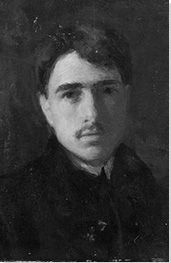Summary of Roger de la Fresnaye
Although la Fresnaye is rightly connected with the Cubist movement, he is generally viewed as something of a gentle free spirit whose interest in radical cubic forms was moderated by his dedication to figurative art. A contributor to two landmark exhibitions, La Section d'Or in Paris in 1912, and the American Armory Show of 1913, he belonged to the so-called Salon Cubists whose experiments with geometric forms allowed for the "distraction" of color. La Fresnaye came from an aristocratic background and he was a fiercely patriotic man whose life was cut short due to health complications suffered while serving at the front during World War One. His heroic military paintings focused on soldiers' life in the field, but in the post-war years, and as poor health took its physical toll, la Fresnaye abandoned his interest in Cubist forms in favor of contemplative works executed in the realist idiom.
Accomplishments
- La Fresnaye produced a vivid style of art that took a direct lead from the Orphism of Robert Delaunay. While he borrowed from Delaunay his wonderful sense of color and line, la Fresnaye's large scale canvases, which favored bold blues, yellows, and reds, shied away from his colleague's push towards collage and abstraction in favor of a figurative art that gave rise to a more accessible, and therefore more popularized, version of Cubism.
- Although La Fresnaye might have been considered one of the more conservative members of the Cubist fraternity, he had in fact fully engaged in the experimental spirit of the modernist age. Having absorbed the Symbolist influences of the Nabis group, the subjectivity of the German Expressionists, and the geometry of the Cubists, he found a way to blend these influences while never leaving behind his affections for classicism (and especially his admiration for El Greco).
- In the years following his military service, the ailing la Fresnaye abandoned the city for the cleaner air of the Mediterranean coast. Leaving his modernist proclivities behind, he turned his attention to portraiture and landscapes which he executed a realistic manner. These moving pieces, which carry a pronounced lyrical and spiritual element, tallied with the idea of a man facing up to the final years of his life.
The Life of Roger de la Fresnaye
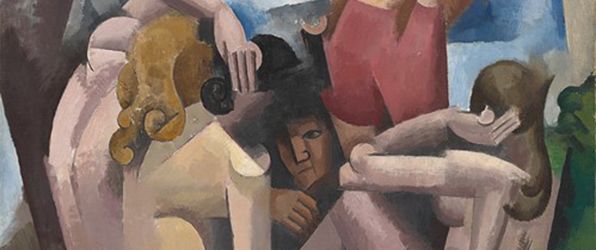
Art historian Rosamund Frost writes: "In their uniform youth the Cubists painted much alike. However, from the start Roger de la Fresnaye stands to as an individual. Fresnaye had what we would consider a modern mind [...] He sensed the attraction of industrial life without going in, as some did, for a slavish worship of machines".
Important Art by Roger de la Fresnaye
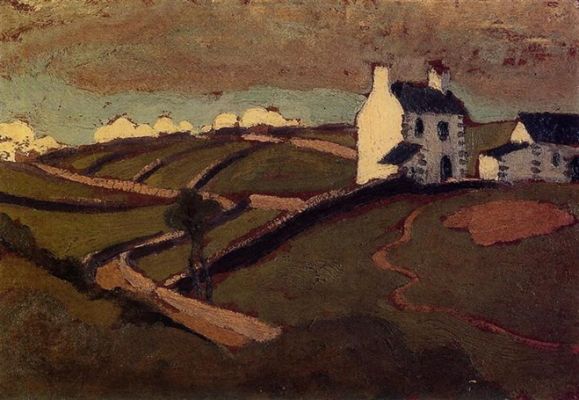
White House at Audierne
In this work, a rural landscape scene is presented, with stone walls dividing farmland, and a white house and secondary building being visible at the right-hand side. Fluffy white clouds gather at the horizon, and the sky is a smoky grayish brown. Many of la Fresnaye's early works were landscapes. This work was inspired by a visit to the town of Audierne during a bicycling tour of Brittany, in western France, in the summer of 1909. Other paintings, including rural market scenes, featured figures.
This painting was produced while, or shortly after, La Fresnaye was trained at the Académie Ranson where he was tutored by three key figures associated with the Les Nabis movement, Paul Ranson, Maurice Denis, and Paul Sérusier. The painting represents the Les Nabis philosophy that art should be subjective (rather than realist) and should pursue a harmonious match of line and color style that emphasized pattern and color. Like these artists, la Fresnaye used vivid colors and a flattened perspective to present the undulating landscape with a dreamy, symbolist, quality.
Oil on canvas - Private collection
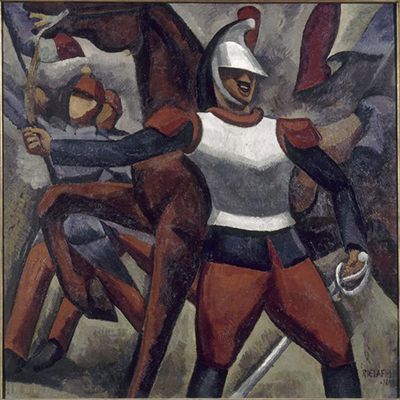
Cuirassier
In Cuirassier ("cavalry soldier"), la Fresnaye offers his unique re-interpretation of Géricault's The Wounded Cuirassier (1814), in which an anonymous soldier descends a slope, guiding his trepidatious horse by the reins. Géricault intended his work to serve as a riposte to the heroic history paintings by presenting a scene of soldier (or, indeed, a nation) resigned to defeat. In Géricault's work, the Cuirassier is not visibly wounded, lending to the interpretation that the title of the work refers rather to the soldier's wounded ego and pride.
La Fresnaye's painting carries the theme of strength and determination, with the soldier smiling or shouting and standing tall and proud in front of his men, and his horse prancing fearlessly. The painting is dominated by the colors of the French flag (indeed, one can see the tricolor a in the top left corner of the painting) which represents the artist's strong sense of patriotism (no doubt passed down by his father who was a French army officer) while the geometric Cubist forms, delineated by lines and curves, lend the figures an extra sense of solidity. The work was shown at the Salon des Indepéndents of 1911, where the famous poet, playwright, and art critic, Guillaume Apollinaire (himself a strong proponent of Cubism) called it "an excellent piece", adding that "this artist approaches military painting with complete frankness and brand new means".
Oil on canvas - Museum of Fine Arts of Lyon, France
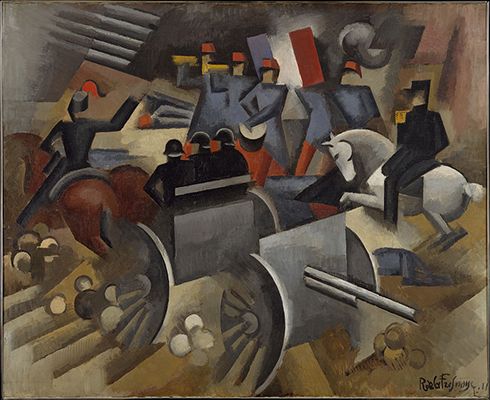
Artillery
This Cubist work was executed leading up to the outbreak of World War One, at a time when national pride was strongly felt by the French. In it, la Fresnaye, who didn't hesitate to join France's army when the war broke out (in 1914), depicts a militia company, with soldiers on horseback at either side escorting a caisson (a wagon used for moving artillery and ammunition) at the front center, and in the background, a military band with their instruments stand in front of a French tricolor. The figures are delineated by nearly flat fields of color and strong, orderly geometric shapes and lines.
By 1911, la Fresnaye was fully engaged with Cubist techniques. However, while other Cubists, notably his friend Robert Delaunay, tended to focus more on abstracted geometric forms, la Fresnaye remained committed to the figurative. Art historian Stephanie Przybylek asserts that, while the work's shapes "are simplified and emphasized with splashes of bold color", la Fresnaye has also "captured the rhythm of movement of large weapons of war, horses and guns pushing forward". It seems that he has found in Cubism a style that allowed for the rhythmic movement and muscular strength of such a military scene. Indeed, the painting carries the influence of Neo-Classicism and it is known that la Fresnaye had painted many copies of the works of the Spanish Mannerist, El Greco.
Oil on canvas - The Metropolitan Museum of Art, New York City
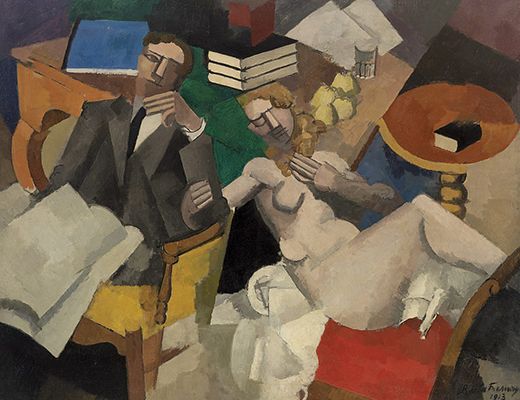
La Vie Conjugal (Married Life)
In this work, a man in a suit with a newspaper on his lap is sitting in a yellow armchair on the left-hand side, with his right arm under the newspaper pages, and his left elbow resting on the arm of the chair, his hand resting beneath his chin. To the right, a nude woman reclines on a red dining chair, her left arm curled around the man's right arm, and her head leaning back against a rectangular wooden table upon which sit books, a glass, and four small yellow bags (possibly containing money). One of the man's eyes is clearly open, while the woman's eyes appear shut. There is also a smaller round wooden table, with a black book on top, at the upper right of the frame. In la Fresnaye's typical Cubist style, the image is dominated by flat geometric shapes and fields of bold colors.
The artist painted this work shortly after he began associating with the Cubists and joined the Section D'Or group. He uses common techniques of early Cubism, such as passage, removing some outlines and allowing the fields defining certain objects to, in effect, blend into or overlap with others (such as the man's face and the large table). Scholar Douglas Cooper criticized Married Life as "lacking pictorial reality" and as "disconcertingly angular because [la Fresnaye] lacked conviction in his handling of cubist methods". Cooper also said that La Fresnaye's Cubist works "have a brittle, disjointed quality which belies his aspiration to represent the solid earthy aspects of reality".
Cooper's view was not shared by the historian Maureen Mullarkey who wrote: "The Conjugal Life is a delightful performance. Disengaging from the laws of perspective, La Fresnaye views the figures straight on, essentially at eye level. But everything behind them - the table tops, the books, the fruit plate - are viewed from above. The diagonals of the out-of-perspective table frame the figures, locking them together in a pictorial analogy to the doublet that is marriage. It is a marvelous, rhythmic performance that keeps the eye returning to the figures. The couple, tilted toward each other, never lose their intelligibility to Cubist planar structures. In compositional technique, the painting is clearly modern; its humanity and reticence are classical. (Evident in the clothed male together with the nude female viewed from her right side, and accompanied by the emblematic fruit platter, is an amiable, quotidian - that newspaper! - nod to Manet's Luncheon on the Grass. )".
Oil on canvas - The Barnes Foundation, Philadelphia, Pennsylvania
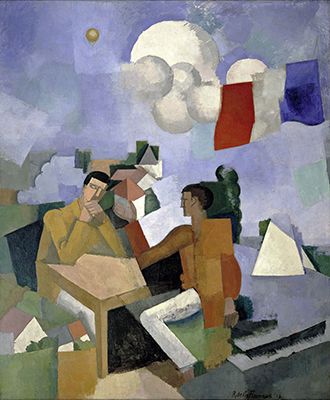
The Conquest of the Air
In this work La Fresnaye paints himself in conversation with his brother, an engineer in the Nieuport aeroplane company. They are seated at a wooden table in an outdoors setting. To the left lay shapes that recall fields and houses; to the right, a river, trees, and a sailing boat. Above them, a small yellow air balloon, a French flag, and spherical white clouds float against the backdrop of the clear blue sky. With its lyrical use of colorful and prismatic shapes, the painting reflects the growing influence on La Fresnaye of Robert Delaunay and his Orphism movement. However, unlike pure Orphic works, which embrace pure abstraction, la Fresnaye kept faith with representational art.
The historian Maureen Mullarkey notes that Conquest of the Air was painted "little more than a decade after the Wright brothers' triumph at Kitty Hawk" and that this "glorious, mural-sized expression of exhilaration" amounted to a response to the "glistening new age of aviation". But the painting has a more patriotic meaning. Mullarkey observes that the "yellow ball in the sky" references the "first manned balloon flight launched over France by the Montgolfier brothers in 1783 [which is] a milestone in aviation history [...] Viva le tricolor !". But for Mullarkey, "The splendor [of the work] is all in the paint. Conquest of the Air is an astonishing act of painting". She concludes, indeed, that when the painting was put "on permanent view at the [Museum of Modern Art, New York] painters of all stripes stopped in to 'make a visit,' as Catholics used to do when passing a church".
Oil on canvas - Museum of Modern Art, New York City
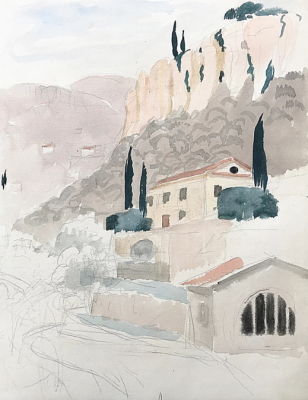
Maison de Grasse aux deux Cyprès
In the final years of his short life, the infirm la Fresnaye turned away from Cubism, describing it as "too systematic and radical". He turned instead to realist representations amongst which were several gentle, meditative landscapes. This watercolor shows buildings sitting on a slope beneath a rocky cliff. The scene is punctuated with dark trees and shrubs. The shape of the tall trees recalls cypress trees and, considering the style of the building and the geological characteristics of the scene, the viewer gets a sense of being in, or near, the Mediterranean.
In fact, the title informs us that the image was produced in Grasse, on the French Riviera. La Fresnaye moved there in 1920 with his friend, Swiss artist Jean-Louis Gampert, before eventually settling into the Villa Félicie at the highest point of the town, which is the upper building visible in this painting. In addition to landscapes, he also painted a few self-portraits and portraits of his closest friends.
Watercolor on pencil lines on page of a sketchbook - Galerie des Modernes, Paris, France
Biography of Roger de la Fresnaye
Childhood
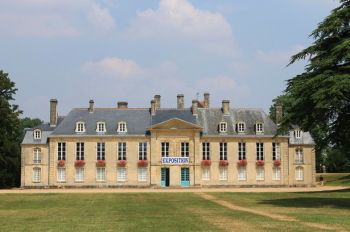
Roger Noël François de La Fresnaye was one of two sons born in Le Mans, France, where his father, an officer in the French army, was temporarily stationed. His father came from an aristocratic family whose stately ancestral home, Château de la Fresnaye, was near Falaise in Northwestern France. Little else is known of his childhood or his roots.
Education and Early Training
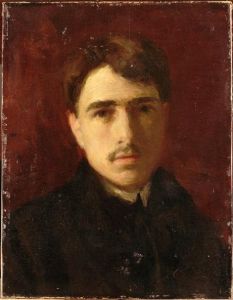
Having completed his private school education, la Fresnaye studied in Paris at the Académie Julian between 1903-04, at the École des Beaux-Arts between 1904-08, and at the Académie Ranson between 1908-09. Here his teachers included three key figures within the Nabis movement, Paul Ranson, Maurice Denis, and Paul Sérusier.
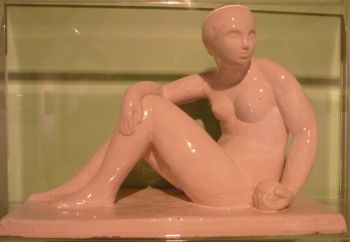
La Fresnaye benefited from the vibrant artistic and cultural environment in Paris at the time, where he felt free to explore and experiment with new styles. Having already absorbed the influences of Ranson, Denis, and Sérusier, in 1909, he travelled to Munich, where he encountered the German Expressionists, and then, in 1911, to northern Italy where he began to introduce more cuboid and abstract elements into his own painting. During this period he also experimented with sculpture, working with Aristide Maillol at the Académie Grande-Chaumière in Paris.
Mature Period
In 1912, Groupe de Puteaux (The Puteaux Group), formed by Jacques Villon and Raymond Duchamp Villon, came together at the former's house (in the Parisian suburb of Puteaux). The group, that would welcome such names as la Fresnaye, Albert Gleizes, Jean Metzinger, Juan Gris, Robert Delaunay, Marcel Duchamp, Francis Picabia, and Fernand Léger, were united in their quest to explore a more broadly defined, less rigid, mode of Cubism - one than moved beyond the monochromatic and muted color palettes favored by Picasso and Braque. As Gleizes stated, "It was at this moment [...] that we discovered each other seriously [and] realised what we had in common. The necessity of forming a group, of frequenting each other, of exchanging ideas seemed imperative".
In the fall of 1912, the Puteaux Group (also known as the Salon Cubists) put on their famous exhibition, La Section d'Or (Golden Section), at the Galerie la Boétie in Paris (the name had been suggested by Villon who was interested in the ancient concept of the golden section (section d'or), as a way of perfecting the Cubist concern with geometric forms and mathematical proportions). The exhibition was augmented by Gleizes's and Metzinger's groundbreaking treatise Du Cubisme and the double impact of the exhibition and the publication of Du Cubisme has gone down as a landmark event in the history of avant-garde art.
Le Fresnaye was also involved in the design of the Maison Cubiste (otherwise known as the "Hotel Project") which was an architectural installation presented at the Salon d'Autumn, also in 1912, and then in the following year at the famous Armory Show in America. The house, displayed in the "decorative arts" section, was a prototype - described by historian Jose Rivero Serrano as a "stage set made with plaster" - for a Cubist apartment block. The pavilion's façade was designed by Duchamp -Villon with the interior layout designed by Andre Mare. La Fresnaye created the interior doors, watches, candlesticks, and other decorative fixtures and fittings. The Maison Cubiste was in fact conceived of "in the bourgeois way, colorful and quite traditional, particularly in comparison with the exhibited paintings". But, as Serrano adds, "Despite its meekness and conservatism, the installation was attacked by some critics as extremely radical, which helped its premature success and the spread of the term Cubist, which began to be applied, inappropriately, to everything from modern haircuts to women to theatrical performances [and] from painting to sculpture".
La Fresnaye was strongly influenced by Robert Delaunay who had developed his abstract Orphism style that focused on color, movement, and energy. However, la Fresnaye retained a figurative approach and never embraced full abstraction. Historian Maureen Mullarkey writes, "he never abandoned legibility, or the dance of color that linked him to Robert Delaunay's Orphic variety of Cubism. His greatest work held true to visual as well as to tactile reality". In January 1913, he published an article about Post-Impressionist artist Paul Cézanne, in which he backed Cézanne's argument that artists should "treat nature by means of the cylinder, the sphere, the cone, everything brought into proper perspective so that each side of an object or a plane is directed towards a central point".
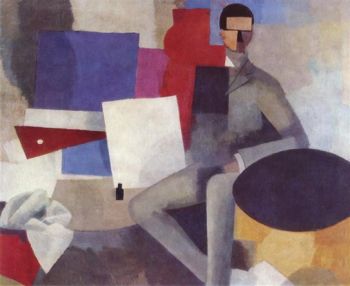
In 1914, shortly before the onset of World War One, la Fresnaye was given his first solo show at the Galerie Levesque. Historian Anne Areeley states that by the time of the exhibition he had become known amongst his peers for his "conservative handing of cubist methods and techniques" and a "classicizing approach, by which he converted natural forms into a harmoniously balanced configuration of simplified planes and arcs rendered in pure, luminous color".
Late Period and Death
As the son of a high-ranking French army official, and a proud patriot, la Fresnaye was eager to join the war effort and enlisted with the French army. He documented the scenes he witnessed on the front line in drawings and watercolor paintings. He focused on the bravery and strength of his comrades-in-arms. He was discharged in September 1918, just two months before the Armistice, having contracted tuberculosis and having suffered two subsequent lung hemorrhages. Following a brief stay in Paris, he was moved to a sanatorium in Cambo-les-Bains in the South of France. Sadly, his health was by then in terminal decline.
In 1920, la Fresnaye moved with his friend, the Swiss painter and illustrator Jean-Louis Gampert, to Grasse, in the Alpes-Maritimes area of the French Riviera. They moved to a small house on the outskirts of the city before settling in the Villa Félicie which was situated above the terraced hills of the city. Here they were joined by the French painter Alfred Courmes. Mullarkey writes that "By 1922, La Fresnaye no longer had the stamina to work in oils. Standing at the easel for long periods was no longer possible; the sustained exertion required by large canvases had become too much. Works from the last three years of his life were smaller in size, created on paper with crayon, watercolor, or gouache". Gampert wrote that la Fresnaye spent much time in the garden drawing and painting, shaded by a tarpaulin overhead.
While at Villa Félicie he became close friends with neighbors, Victor Sandeman, a British colonel, Germaine de Joncquières, the daughter of an admiral, and "Lebel", an architect. Gampert also recorded that French composer Francis Poulenc spent some time at a nearby house, and la Fresnaye executed several portraits of him during his stay. La Fresnaye died at the age of 40, with Gampert serving as his primary caregiver throughout his palliative spell. La Fresnaye's friend and supporter, French writer Constance Coline, recorded that he was "an attractive and distinguished young man," and that French aviation engineer Henry Kapferer "rightly regarded him as one of the hopes of his generation". The art dealer and historian, Germaine Seligman, remarked that, "Though his death did not occur until 1925, the war cost him his life as surely as though he had fallen on the battlefield".
The Legacy of Roger de la Fresnaye
While we might label him "Cubist", la Fresnaye developed an idiosyncratic style - somewhere between Orphism and figurativism - that has made him hard to pigeonhole. It is a position not helped by a career cut short by premature death. The art collector René Gaffé argued that "If La Fresnaye attached such particular attention to cubist theories, it is because they reflected great purity" and that "if we absolutely have to label his talent, we can consider him as a progressive cubist, a lyrical cubist I would say, who sacrificed to pure color with austerity".
Mullarkey writes "Four years at the front, followed by their legacy of lung infections, circumscribed his productivity. This, together with few earlier sales and the lack of any known patron of standing, hampered recognition". It was not until a quarter century after his death, she adds, that the French arts establishment finally paid "homage to one of its major painters with an extensive exhibition at the Musée d'Art Moderne", and that "appreciation of his work was [still] in its infancy when Seligman's catalogue raisonné, published by the New York Graphic Society appeared in 1969". Mullarkey concludes, however, that he was always "beloved among painters" - his influence can be traced in the works of André Lhote, Auguste Herbin, and Gino Severini, as well as Mexican Muralists, Diego Rivera and Jose Clemente Orozco (whose works bear a strong stylistic resemblance to Fresnaye's military paintings) - but perhaps his art has still yet to "receive its due in public".
Influences and Connections

-
![Jacques Villon]() Jacques Villon
Jacques Villon - Dunoyer de Segonzac
- Jean-Louis Gampert
- Francis Poulenc
-
![Gino Severini]() Gino Severini
Gino Severini -
![Diego Rivera]() Diego Rivera
Diego Rivera - André Lhote
- Auguste Herbin
-
![Jacques Villon]() Jacques Villon
Jacques Villon - Dunoyer de Segonzac
- Jean-Louis Gampert
- Francis Poulenc
Useful Resources on Roger de la Fresnaye
- R. de La FresnayeOur PickBy Roger Allard
- The Arts in France: From the Time of Louis XIV to the Present Day - A Brief SurveyBy Amelia Dorothy Defries
- Contemporary Art - The March Of Art From Cezanne Until NowBy Rosamund Frost And Aimee Crane
- The Liberation of Painting: Modernism and Anarchism in Avant-Guerre ParisBy Patricia Leighten
- Roger de la Fresnaye,: With a Catalogue RaisonnéBy Germain Seligman
- Apollinaire, Cubism and OrphismBy Adrian Hicken
- Orphism: The Evolution of Non-Figurative Painting in Paris, 1910-1914 (Oxford Studies in the History of Art and Architecture)By Virginia Spate
- Resisting Abstraction: Robert Delaunay and Vision in the Face of ModernismBy Gordon Hughes
 Ask The Art Story AI
Ask The Art Story AI